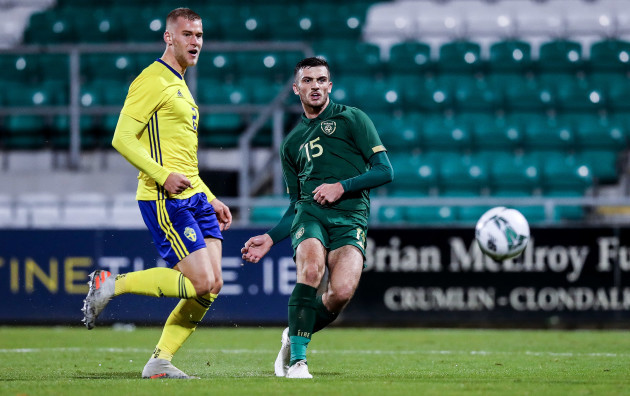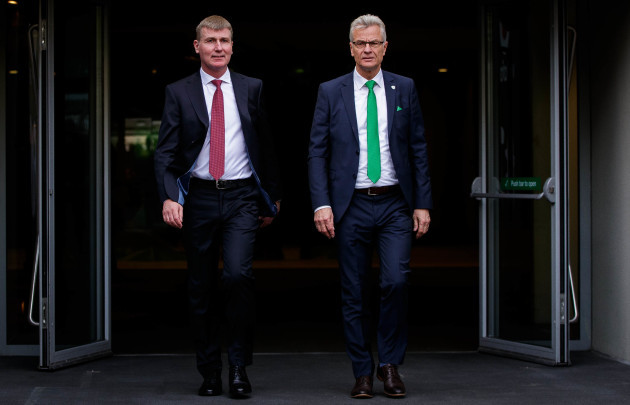AFTER ALMOST TWO years of major internal upheaval, the world may be about to change Irish football from the outside, too.
With Britain transitioning out of the European Union, their football clubs have had to reassess how they recruit players from the EU, including Ireland.
Under Fifa’s rules, clubs can’t sign a player from another country until they turn 18, but there’s an exemption for transfers between one EU country and another. In that instance, players can move when they are 16 once the purchasing club makes a provision for education.
This EU exemption has lighted the well-worn path across the Irish Sea for youngsters for years, and leaving for the UK from 16 has been the surest path to senior international honours for Irish players for generations.
Between 30 and 50 players aged 16 or 17 are estimated to move from Ireland to UK clubs every year, and this has been the avenue even for the freshest batch of Ireland’s top talent, including Troy Parrott (Tottenham), Caoimhin Kelleher (Liverpool), Adam Idah (Norwich), Jason Knight (Derby County), Aaron Connolly and Jayson Molumby (both Brighton.)
But now it may all be about to change. We say may as this is Brexit we’re dealing with: nothing is ever quite clear-cut.
Indications early this month were that the Republic of Ireland would fall into line with the rest of the EU when it came to sending young players to the UK, and players could not move until they turn 18.
Some had hoped Irish youngsters would get the same exemption as those over the age of 18, under the Common Travel Area (CTA), an agreement between the Irish and British governments that is separate to the EU and allows citizens to move freely between and enjoy rights within both jurisdictions.
But this is Fifa’s call, and so far, it seems they are sticking with their own rules and not exempting Irish youngsters under the CTA.
A senior English Football League source told The42 there is no exception for young Irish players, and earlier this month the sports law firm Mills & Reeve reported a Fifa Council meeting on 4 December made no exception for the Republic of Ireland.
But it’s not a done deal. Some UK clubs have continued efforts to recruit in Ireland as normal, and an FAI spokesperson says Fifa have told them the debate is “by no means closed.”
If it does take effect, it will be a profound change for Irish football. Players can still move at 16, though to clubs within the EU – which in itself would be a major cultural change for Irish football – while some in the game believe the UK clubs with EU feeder clubs (like Manchester City and Brighton) will use them to recruit and hothouse EU talent.
If neither of those avenues are pursued, Irish football will be charged with providing for its very best talent for an additional two years, which brings ample opportunities along with fraught challenges.
The UK academy system is absurdly tough and competitive: author Michael Calvin calculated that just 1% of English kids who join academies from the age of nine go on to make a living in the sport.
The League of Ireland is filled with twentysomething-year-olds getting over the disenchantment bred by a difficult spell in England, and that our most talented players would now be going over with more maturity and a solid education behind them is an advantage of this potential new world.
“There are benefits: you’re physically stronger and mentally more mature”, says Patrick Conliffe, head of football agency, Quantum Sport Ireland.
“A 17-year-old who breaks into a League of Ireland first team is probably at more of an advantage than a 17 year old playing U18 or U23 league football in England. There’s no substitute for playing competitive men’s football.”
Those potential positives, however, are dwarfed by the present challenges.
“We don’t have a football industry in this country”, says Alan Caffrey, Head of Youth Development at Saint Kevin’s boys. “Most of the clubs aren’t full time, so if your first team aren’t full-time then you won’t have a full-time schoolboy section with full-time coaching staff at academy levels.
“There has been a lot of talk on social media that the Brexit ruling will be good for Irish football, but we’ll see about that. I don’t think it will. We’re in hard times with the senior international team at the moment, but that will be nothing like what it could be like five years’ down the line.”
Will Clarke is Academy Director at Bray Wanderers, and he says the current structures are not adequate to produce a generation to match those currently breaking into Kenny’s senior international team.
“I don’t think we do at the moment, to be honest with you. We just aren’t set up at the moment to give those kids a chance of developing. While in the short-term we are okay with the [players born in] ‘99s, ’00s, ’01s, but go to the ’03s and younger and I think we are in a little bit of trouble.”
It’s a money problem: Irish football just can’t cope with the chasm to the elite academies of the English Premier League. To qualify for the top Category One status, for instance, English academies must have a minimum of 22 full-time academy staff. That’s more than twice the total full-time academy staff across every club in Ireland.
“Contact time is a big thing”, says Clarke. “There are no full-time academies here for us. A typical week here at U15, U17, and U19 level would be to train three or four evenings a week and then have a game at the weekend. You’re probably looking at around six hours contact time a week for our players who are based here. In the UK you’ll have at least 15 hours contact. English clubs take a multi-disciplinary approach to things, so they have their coaching on the pitch but also an S&C programme, analysis, feedback. Here, we are trying to cram everything in as best we can into three or four evenings a week.
“It’s always struck me as to why they [players at UK academies] were better technically than us, and it’s because they have far more time to concentrate on the basics that we do. Here, because we are trying to cram everything in, sessions can be very generic.
“As an example, I’m taking an U17 team in Enniskerry tonight, we have an hour and a half on half an Astro. I’m putting on a generic session to accommodate 20 kids. The session will be fine and will run well, and the kids will get lots of the ball. But you need to take the time to make it really specific, ‘Okay, we will do some work with our full-backs here, and work with our strikers here.’
“That just takes time. That was one of the biggest learning curves for me. When you go to the UK you’re expecting the sessions to be really top class, but it’s not even that, it’s that they spend more time trying to master the basics. They have more time to concentrate on the individual as opposed to concentrating on the team.
“We are very lucky with the quality of people we have working in youth development in this country, but because it’s not their sole focus, you don’t have enough time and sessions to work with individuals, so that leads to more generic sessions.
“We’ve known that Brexit has been coming down the road, all of a sudden now it’s imminent and we still haven’t put anything in place to compensate for the level of football education kids would receive in the UK compared to here. I hate saying that, but that’s the reality.
“To be fair to the likes of Shamrock Rovers and everyone else, anything positive that has happened has been club-led. It hasn’t been led by the Association. I wouldn’t criticise anyone, but that’s just the fact of the matter.”
The FAI haven’t been able to implement any specific provisions for the potential Brexit challenge as the new regime have spent much of their time and money reckoning with the lousy legacy they inherited from the Delaney Days.
Delaney’s outlook on the Brexit issue was revealed in a 2018 letter to then-sports minister Shane Ross, asking the government to keep the exception for 16-year-old Irish players in mind when negotiating with London.
Now he’s gone and the FAI have greater concerns. They have carried almost €70 million of debts into 2020, and that’s before they account for the ruinous impact of the pandemic. The dysfunction of 2019 had a very direct impact on youth structures: the loss of half a year’s State funding saw money ring-fenced for Player Development slashed from €400,000 to €80,000.
At a time when Irish football should be moving on, it’s instead battling to stand still.
The FAI acknowledged the need to improve structures here when asked to comment for this piece, citing the importance of the Association’s Player Development Plan.
“The Association is conscious of the potential impact of Brexit on our young talent, our clubs and our international teams. To that end, the Player Development Plan is more important now than ever before. It is essential that the FAI continues to grow and improve our academy structures here at home, in association with our League of Ireland and schoolboy and schoolgirl clubs and affiliates, to ensure a clear pathway to the top for our young players. Together, we must also develop our relationships with the game in other EU member states so that there are real options in Europe for our under 18s.”
The Player Development Plan was unveiled in 2015 by High Performance Director Ruud Dokter, and included in it was the introduction of National U13, U15, U17 and U19 leagues along with the fraught and painful amalgamation of schoolboy and League of Ireland clubs to form academies to compete in those leagues.
A member of the Dutch football Hall of Fame, Dokter is well regarded by many at the FAI. He is credited with bringing cohesion to the underage international teams and his contacts book has greatly enhanced the FAI’s Coach Education Programme, which held up as one of the few stable sources of income for the FAI last year.
The FAI have had a battle to keep parts of the Player Development Programme together this year, though, with Gary Owens and Niall Quinn talking the Dublin District Schoolboy League (DDSL) out of a planned revert to 11v11 from 9v9 at U12 level.
Dokter has put a few noses out of joint during his time, and the Schoolboy Football Association of Ireland informed the FAI of a motion of no confidence in him when it emerged this year that Dokter was set for a contract extension.
One of the issues has been a lack of direct contact and engagement with the various grassroots on Dokter’s part, with some long-serving schoolboy coaches feeling disenfranchised in the fusion with League of Ireland clubs.
A lack of consistent engagement has been an issue at academy level, too: the last time Dokter met with all academies at the same time was more than two years ago, in October, 2018.
Though the academy structure in Ireland desperately needs money, Clarke pinpoints a couple of ways in which they can improve without the need for investment. One is that the FAI introduces specific, objective criteria to audit the performance of individual academies.
“It beggars belief”, says Clarke. “If you look at every academy system in Europe, clubs are audited based on their work. That’s how they receive funding. If you’re doing a good job, the Association will give you X amount, and they won’t give as much to those not doing a good job. Until that auditing system is in place and we have criteria in place, it’s all subjective.”
Regardless of whether the Brexit ruling takes effect or not, Clarke also wants the FAI to extend registration periods for underage and amateur players by at least one year, so as to give academies a better chance of making more money. Players are currently only registered for a year a a time, which leaves clubs shortchanged if they can’t sign the player to a professional contract.
“If our best kids are going to England at 16, we need to come up with a mechanism to make sure we have a kid registered for two years, and are registered for their 16th birthday and their 17th birthday.
“So when Liverpool come knocking on Shamrock Rovers’ door looking for a player because he’s 16 now, at least if he has 12 months left on his registration period it gives Shamrock Rovers leverage to turn around to Liverpool to say, ‘Well he’s still registered with us for another 12 months so if you want him now, you’ll have to pay additional money.’
“The reason Rovers got money for Gavin Bazunu is because they sold Gavin as a professional to Manchester City. That’s what allowed them to generate €500,000. If Gavin hadn’t signed a professional contract with Shamrock Rovers then they would only have been entitled to the Uefa compensation, which would have been roughly €150,000.
“If you look at the Irish players breaking through – Parrott, Knight, Connolly, Idah, Nathan Collins, Molumby – there are probably 20 Irish players who are 18 or 19 and are playing either first-team Championship football or on the fringes of Premier League squads. If that was any other country in Europe people would be saying, ‘Jesus, what’s going on in Ireland? They are obviously doing something right.’
“But we are developing all of these players with little or no resources and we are not getting the value we deserve for it.
“We can change the structure and some of the rules to allow us to generate more income. You can’t look for a handout all the time, you have to create opportunities to increase income back into the game.”
[image alt="Rise_Of_Kenny_final" src="https://cdn.thejournal.ie/media/2020/10/rise_of_kenny_final.jpg" width="100%" height="" wp-size="size-full" credit-url="" credit-source="" credit-via="" credit-via-url="" caption="" title="" wp-id="wp-image-5226998" class="alignnone" /end]




